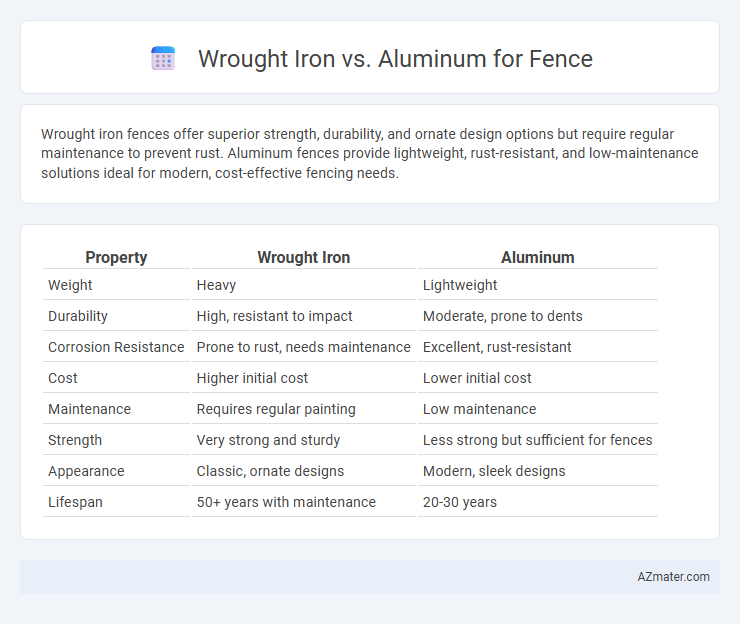Wrought iron fences offer superior strength, durability, and ornate design options but require regular maintenance to prevent rust. Aluminum fences provide lightweight, rust-resistant, and low-maintenance solutions ideal for modern, cost-effective fencing needs.
Table of Comparison
| Property | Wrought Iron | Aluminum |
|---|---|---|
| Weight | Heavy | Lightweight |
| Durability | High, resistant to impact | Moderate, prone to dents |
| Corrosion Resistance | Prone to rust, needs maintenance | Excellent, rust-resistant |
| Cost | Higher initial cost | Lower initial cost |
| Maintenance | Requires regular painting | Low maintenance |
| Strength | Very strong and sturdy | Less strong but sufficient for fences |
| Appearance | Classic, ornate designs | Modern, sleek designs |
| Lifespan | 50+ years with maintenance | 20-30 years |
Introduction to Wrought Iron and Aluminum Fences
Wrought iron fences are renowned for their durability, strength, and classic ornamental designs, making them a popular choice for decorative and security purposes. Aluminum fences provide a lightweight, rust-resistant alternative with low maintenance needs while mimicking the appearance of wrought iron. Both materials offer distinct advantages in aesthetics, longevity, and cost, suitable for different fencing requirements.
Material Composition and Properties
Wrought iron fences are composed primarily of iron with a low carbon content, offering exceptional strength, durability, and resistance to bending, making them ideal for security and decorative purposes. Aluminum fences consist of lightweight aluminum alloy, providing excellent corrosion resistance, minimal maintenance, and easy installation, but with less structural strength compared to wrought iron. The inherent density and tensile strength of wrought iron contribute to higher durability under impact, whereas aluminum's oxide layer enhances longevity in harsh weather without rusting.
Aesthetic Appeal and Design Options
Wrought iron fences offer intricate, handcrafted designs with a classic, ornamental aesthetic that enhances traditional and historic properties, while aluminum fences provide a sleek, modern appearance with versatile styles including picket, flat-top, and ornamental patterns. Aluminum allows for a broader range of color finishes due to its powder-coated surface, offering both durability and customization without the risk of rust. The choice between wrought iron and aluminum impacts the fence's visual appeal, with wrought iron favored for elegance and intricate detailing, and aluminum chosen for lightweight, low-maintenance design flexibility.
Durability and Longevity Comparison
Wrought iron fences exhibit exceptional durability due to their robust, dense composition, resisting impact and harsh weather conditions with minimal corrosion when properly maintained. Aluminum fences offer superior longevity in terms of rust resistance, as aluminum naturally forms a protective oxide layer, making them ideal for humid or coastal environments. While wrought iron requires periodic upkeep to prevent rust, its strength surpasses aluminum, which is lighter but may dent or bend more easily under physical stress.
Maintenance Requirements
Wrought iron fences require regular maintenance, including rust prevention treatments and periodic repainting to avoid corrosion and maintain structural integrity. Aluminum fences are highly resistant to rust and corrosion, making their upkeep minimal, typically involving only occasional cleaning with soap and water. Choosing aluminum reduces long-term maintenance costs and effort compared to the more labor-intensive care wrought iron demands.
Security and Strength Factors
Wrought iron fences offer superior security due to their dense, heavy construction and high tensile strength, making them resistant to cutting or bending. Aluminum fences provide a lighter alternative but lack the same level of durability and impact resistance, making them less secure against forced entry. For maximum strength and long-term protection, wrought iron remains the preferred choice in high-security fencing applications.
Cost Analysis: Wrought Iron vs Aluminum
Wrought iron fences typically carry higher upfront costs due to labor-intensive fabrication and heavier material weight, with average prices ranging from $30 to $50 per linear foot. Aluminum fences offer a more budget-friendly option, costing between $20 and $35 per linear foot, while providing corrosion resistance and lower maintenance expenses over time, which reduces total ownership costs. Maintenance costs for wrought iron include periodic rust treatment and repainting, potentially increasing lifetime expenses compared to aluminum's weather-resistant coating that minimizes upkeep.
Installation Process and Flexibility
Wrought iron fences require skilled labor for installation due to their heavy weight and rigid structure, often involving welding and precise alignment, which can increase time and cost. Aluminum fences offer greater flexibility with lightweight panels that are easier to handle and install, typically featuring pre-fabricated sections and snap-together components that reduce labor intensity. The malleability of aluminum also allows for customizable configurations and adjustments during installation, making it ideal for irregular terrains or complex layouts.
Environmental Impact and Sustainability
Wrought iron fences are highly durable and can last for decades, reducing the need for frequent replacements, but their production involves significant energy consumption and carbon emissions due to iron smelting and forging processes. Aluminum fences require less energy to produce, are lightweight, and are fully recyclable, making them a more sustainable choice with a lower environmental footprint. Both materials offer recyclability, but aluminum's resistance to rust reduces maintenance needs and chemical treatments, enhancing its overall environmental benefits.
Choosing the Right Fence for Your Needs
Wrought iron fences offer exceptional durability, ornate designs, and superior security, making them ideal for homeowners seeking a strong, long-lasting perimeter. Aluminum fences provide lightweight, rust-resistant, and low-maintenance options with versatile styles suited for both decorative and functional purposes. Evaluating factors like budget, climate, maintenance preferences, and desired aesthetic helps determine whether the classic strength of wrought iron or the modern convenience of aluminum best fits your fencing needs.

Infographic: Wrought iron vs Aluminum for Fence
 azmater.com
azmater.com